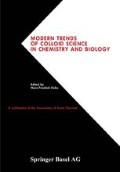Abstract
In many industrial applications of colloidal dispersions, it is the flow properties of the system which are of paramount importance. Sometimes the flow characteristics are important in the properties of the final product (as, for example, in paint and ink preparations). In other cases, the preparation of the final product depends for its success on the proper control of flow properties of a colloidal dispersion or slurry (e.g. in paper making or ceramic casting). In rare cases, when the system consists of spherical particles, stabilised against coagulation and at fairly low concentration, the flow behaviour is Newtonian and characterised by a simple shear viscosity, η, independent of how fast the system is being sheared. More usually, colloidal dispersions are distinctly non-Newtonian and it is this non-Newtonian character which is principally responsible for the desired product characteristics. The simplest and most common type of non-Newtonian shear behaviour occurs when the viscosity depends on how strongly the system is sheared.
Access this chapter
Tax calculation will be finalised at checkout
Purchases are for personal use only
Preview
Unable to display preview. Download preview PDF.
References
Friend, J.P. and Hunter, R.J. (1971) Plastic flow behaviour of coagulated suspensions treated as a repeptisation phenomenon. J. Colloid Interface Sci. 37, 548–556.
Firth, B.A. and Hunter, R.J. (1976) Flow properties of coagulated colloidal suspensions. III. The elastic floc model. J. Colloid Interface Sci. 57, 266–275.
van de Ven, T.G.M. and Hunter, R.J. (1977) The energy dissipation in sheared coagulated sols. Rheol. Acta 16, 534–543.
Hunter, R.J. and Frayne, J. (1979) Couette flow behaviour of coagulated colloidal suspensions: IV. Effect of viscosity of the suspension medium. J. Colloid Interface Sci. 71, 30–38.
Hunter, R.J. (1982) The flow behaviour of coagulated colloidal suspensions. Adv. Colloid Interface Sci. 17, 197–212.
Ekdawi, N. and Hunter, R.J. (1983) Couette flow behaviour of coagulated colloidal sols. VI. The elastic floc model at low shear rates. J. Colloid Interface Sci. 94, 355–361.
Hunter, R.J. and Nicol, S.K. (1968) Dependence of plastic flow behaviour of clay suspensions on surface properties. J. Colloid Interface Sci. 28, 250–259.
Mooney, M. (1951) The viscosity of a concentrated suspension of spherical particles. J. Colloid Sci. 6, 162–170.
Krieger, I.M. (1972) Rheology of monodisperse latices. Adv. Colloid Interface Sci. 3, 111–136.
Goren, S.L. (1971) The hydrodynamic forces on touching spheres along the line of centres exerted by a shear field. J. Colloid Interface Sci. 36, 94–96.
Hunter, R.J. and Frayne, J. (1980) Couette flow behaviour of coagulated colloidal systems. V. Dynamics of floc buildup and breakdown in sheared coagulated sols. J. Colloid Interface Sci. 76, 107–115.
Bagster, D.F. and Tomi, D. (1974) The stresses within a sphere in simple flow fields. Chem. Eng. Sci. 29, 1773–83.
van de Ven, T.G.M. and Hunter, R.J. (1979). Viscoelastic properties of coagulated sols. J. Colloid Interface Sci. 68, 135–143.
Ekdawi, N. and Hunter, R.J. (1984) Sedimentation of disperse and coagulated suspensions at high particle concentrations. Colloids and Surfaces (submitted).
Ekdawi, N. (1984) The sedimentation behaviour of dispersed and coagulated colloidal suspensions. M.Sc. Thesis, University of Sydney.
Buscali, R. (1982) Elastic properties of structured dispersions: a simple centrifuge method of examination. Colloids and Surfaces 5, 269–283.
Steinour, H.H. (1944) Rate of Sedimentation. Parts I–III. Ind. Eng. Chem. 36, 618–624,
Steinour, H.H. (1944) Rate of Sedimentation. Parts I–III. Ind. Eng. Chem. 36, 840–7,
Steinour, H.H. (1944) Rate of Sedimentation. Parts I–III. Ind. Eng. Chem. 36, 901–7.
Author information
Authors and Affiliations
Editor information
Editors and Affiliations
Rights and permissions
Copyright information
© 1985 Springer Basel AG
About this chapter
Cite this chapter
Hunter, R.J. (1985). Rheological and Sedimentation Behaviour of Strongly Interacting Colloidal Systems. In: Eicke, HF. (eds) Modern Trends of Colloid Science in Chemistry and Biology. Birkhäuser, Basel. https://doi.org/10.1007/978-3-0348-6513-5_8
Download citation
DOI: https://doi.org/10.1007/978-3-0348-6513-5_8
Publisher Name: Birkhäuser, Basel
Print ISBN: 978-3-7643-1711-9
Online ISBN: 978-3-0348-6513-5
eBook Packages: Springer Book Archive

